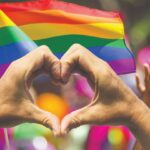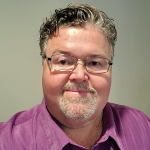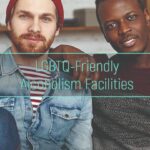Share
In July of 1979, the National Association of Lesbian and Gay Alcoholism Professionals, or NALGAP, was formed. The original charter stated NALGAP’s three primary goals:
- To advocate for good nonhomophobic treatment for lesbians and gays suffering from alcoholism and other drug addiction
- To educate gay and lesbian health professionals about alcoholism/addiction
- To provide support and a communication network for gay and lesbian professionals and other interested people
Now known as the National Association of Lesbian, Gay, Bisexual, Transgender Addiction Professionals and Their Allies, NALGAP celebrated our fortieth anniversary in 2019. A lot has changed over the years in addition to our name.
For instance, we have expanded NALGAP’s mission to confront all forms of oppression and discriminatory practices in the delivery of services to all people, and to advocate for programs and services that affirm all genders and sexual orientations. NALGAP provides information, training, networking, and advocacy about addiction and related problems as well as support for those engaged in the health professions, individuals in recovery, and others concerned about the health of gender and sexual minorities.
The Data
LGBTQ citizens are part of a diverse community that shares a common need for culturally competent health care that recognizes and responds to specific medical risks. Members of the LGBTQ community face greater health challenges than their heterosexual peers due to a combination of differences in sexual behavior; social and structural inequities such as stigma and discrimination; sexual identity development; and coming-out processes and experiences. In 2007, in a survey of 854 treatment programs that indicated they offered specialized LGBTQ treatment, only sixty-two programs (13.77 percent) could acknowledge they actually had such services (Cochran, Peavy, & Robohm, 2007). In 2013, the National Survey of Substance Abuse Treatment Services (N-SSATS) reported that 1,739 of 14,148 substance use treatment programs (8.14 percent) indicated they offered LGBTQ services (SAMHSA, 2014)—almost half of programs surveyed six years prior.
What are LGBTQ services? How do clients and professionals making referrals know what that actually means? For many years, programs could basically say whatever they liked with no accountability. After examining the 2007 study by Cochran et al., this became obvious. Researchers made telephone contact with 854 substance abuse treatment agencies promoting themselves in the N-SSATS as having specialized programs for LGBTQ individuals. Each facility was asked the same question: “Hi, I am calling because your agency is listed in the SAMHSA directory as one that provides special programs or groups for gays and lesbians, and I am interested specifically in what those programs are. Could you tell me more about them?” Here are the results:
- Although all 854 agencies had indicated they provided LGBTQ-specific services, at the time of the phone contact 605 (70.8 percent) acknowledged that no specialized programs existed.
- Sixteen of the agencies (1.9 percent) reported they had offered those services in the past, but no longer did so.
- Seventy-nine programs (9.3 percent) described themselves as “nondiscriminating” (e.g., “We offer the same thing we offer straight people; we do not discriminate.”).
- Thirty-four programs (4 percent) described themselves as “accepting” (e.g., “We do not have special services for gays and lesbians, we just allow them in our groups.”).
- Only sixty-two agencies (7.3 percent) indicated they had specialized LGBTQ programming and almost half were in New York and California.
Only sixty-two programs in the entire country offered specialized treatment for LGBTQ clients out of the 854 programs that listed themselves as having services available in 2007. Furthermore, although 1,739 programs indicated they offered LGBTQ services in 2014, these programs were not asked about the types of services they provided—again, LGBTQ services were not defined in terms of measurable criteria.
There is a high probability that LGBTQ clients will experience substance abuse counseling with counselors who have had no training on providing LGBTQ-specific treatment. Some studies have revealed that 50 percent of substance abuse counselors have received no training at all about LGBTQ issues related to substance abuse (Eliason, 2000).
This continues to be a major concern for NALGAP and the greater treatment community. Having standards of excellence would better ensure that agencies listed as providing LGBTQ services, policies, and staff competencies comply with and utilize best practices.
Creating a Measurable Standard
We have set a goal to develop the NALGAP Center of Excellence, which will assess the level of clinical services, programming, and policy considerations (including HR equality policies) for LGBTQ employees. Additionally, staff competencies, agency policies, and specific services need to be defined, ranked, and accounted for.
The “LGBTQ-Friendly” Treatment Program
“LGBTQ friendly” speaks of the difference between clinical practices and marketing efforts. It is a welcoming acknowledgement of a program’s outreach to LGBTQ communities, just like a hotel labeled as “pet friendly” is helpful if traveling with a pet. As consumers or potential guests, individuals traveling with pets have to investigate whether there are restrictions about pets when making a reservation at any hotels.
For programs to market themselves as “LGBTQ friendly,” we consider they want LGBTQ clients to feel comfortable in their programs and know they are welcome. However, it does not provide insight into what type of clinical services are being offered. In order to establish criteria for differing levels of care, the following need to be assessed:
- What accommodations or considerations are offered for clients who are transgender, nonbinary, or gender nonconforming?
- Going beyond lodging and physical needs, what clinical services are provided to address the needs of LGBTQ clients?
- How do programs truly live out the mission of being LGBTQ friendly versus those with empty marketing rhetoric?
Marketing should not be the only consideration, though for some programs it is a beginning.
LGBTQ-Inclusive vs. LGBTQ-Affirmative
The terms “inclusive” and “affirmative” are not necessarily interchangeable, but providing services that include and recognize sexual minorities is important. Being inclusive is a necessary step to incorporate the awareness of LGBTQ people, who are often left out when discussing representation of client services. Being inclusive can include having didactic lectures and discussions with clients. LGBTQ clients and staff are recognized and respected in an inclusive program.
An LGBTQ-affirmative program will move beyond this recognition. The core issues of trauma, violence, family of origin, family of choice, discrimination, harassment, improved health, heterosexism, and transphobia are addressed in all levels of care. The celebration of the LGBTQ experience and acknowledgement of the diversities of communities are an intricate component of an LGBTQ-affirmative program. This includes affirming the support of LGBTQ staff, board of directors, volunteers, community leaders, and others who play a role in the recovery process.
Defining Best Practices for LGBTQ Clients
What documented standards do agencies have, if any, with regard to measuring a program’s ability to meet the needs of LGBTQ clients? Providing best practices includes markers or criteria that best measure what works. The following areas are ones NALGAP believes are most needed to qualify for the “gold standard” achievement.
A Welcoming Environment
Let us begin with how to create a more welcoming environment. The National LGBTQIA+ Health Education Center recommends various ways organizations can demonstrate affirmation for LGBTQ individuals (Ard & Makadon, 2016):
- Provide health education or marketing materials that depict images of same-sex couples or families
- Make LGBTQ-specific signs, stickers, and brochures visible to clients
- Display community bulletins that include postings for LGBTQ individuals
- Present reading materials (i.e., newsletters, magazines) appealing to LGBTQ clients in waiting rooms
- Ensure that restrooms conform to all genders
Intake
Intake and other forms that recognize LGBTQ individuals make an organization more visible as an ally to all members of the LGBTQ community. Intake and enrollment forms should specifically indicate sexual orientation and gender identities reflective of each individual. Counselors should ask clients which name and pronouns they use, assure that all staff and clients respect everyone’s gender identities, and include corrective action when clients are misgendered.
Programming
Programming should take into consideration that LGBTQ clients face unique challenges in recovery. As a result, treatment plans need to reflect a cognizance of these challenges and should be tailored to meet the needs of this segment of the population with substance use issues. LGBTQ clients do need special consideration of their sexual and gender orientation in order to recover from addiction and reduce the likelihood of relapse. Client treatment and support groups provide safe places for LGBTQ clients to discuss their sexuality issues. Ignoring the sexuality-related issues of LGBTQ persons ignores an integral part of their core being, therefore contributing to a more negative self-image, leading to further harm.
Knowing what sexuality-related issues LGBTQ people experience requires specific training and exposure to client experiences.
Staff Training
Staff training and development should include in-depth understanding of counselor role, client experiences, internalized homophobia, coming out and self-disclosure, minority stress, oppression and stigma, connections of sexual identity to substance use, and counselor self-assessment and countertransference (Badger, 2012). Attending trainings on sexual orientation geared toward values clarification and attitude reassessment are recommended. Proper use of screening, language, referral tools, and agency assessments are important for developing and fostering a healthy environment for treating LGBTQ clients with substance use problems (Badger, 2012).
One helpful tool to assess counselors’ attitudes toward difference is the Riddle Scale (Riddle, 1984), which measures personal bias and attitudes toward LGBTQ individuals. Attitudes can range from repulsion and pity to support and nurturance. If counselors are too low on the scale, they likely will not be supportive or affirming of their LGBTQ clients and this, in turn, can lead to ineffective treatment provision. Program knowledge of counselor attitudes can assist in hiring practices and/or staff development. Counselors will be on their way to being well-rounded once they have done a self-assessment and taken steps to identify any biases, acquired further training, and know what their limitations are, if any.
Sexual Attitude Reassessment
For almost forty years, sexual attitude reassessment (SAR) workshops have been offered to tens of thousands of participants around the US in order to educate health professionals, medical students, clergy, doctors, and the general public about sexuality across the life span, sexual ethics and morals, sexual variations, sexuality and physical disabilities, sexual orientation, negative sexual experiences, and masturbation (Halstead & Halstead, 1983; Held, Cournoyer, Held, & Chilgren, 1974; Rosser et al., 1995; Stayton, 1998; Wollert, 1978). Their dual purpose is to promote an increased understanding of participants’ own sexuality and to help participants analyze their own attitudes toward the sexuality of others.
According to Robinson et al., “The main difference between SAR education and typical sexuality education courses is the use of sexually explicit media which are gradually introduced using systematic principles of desensitization” (2002, p. 45). These materials help participants in clarifying their responses to sex and sexuality; alleviating shame; and enhancing comfort. We would highly recommend a SAR to any professionals who will be working with LGBTQ individuals and sexuality issues in order for them to become immersed in experiential learning. Having the SAR experience enables professionals to understand the sensitive nature of sexuality in a group setting as well as providing a solid base from which to work.
Policy
Policy for staff and clients have some overlap and should ensure that the responsibility for addressing the needs and concerns of LGBTQ clients do not get relegated to one or two staff who are LGBTQ or allies. All staff need to be trained, not just on clinical skills, but also on awareness of how LGBTQ individuals experience life while using and in recovery after treatment. How they live, create families, work, socialize, and love need to be respected and affirmed. As NALGAP initiates the Center of Excellence matrix to help programs identify where they currently are in providing services, the primary intention will be to help them establish policy and initiatives for continual quality improvement and to get positive health outcomes for LGBTQ clients. Other policies might include the following:
- Integrate unique LGBTQ patient needs into new policies, or modify existing policies
- Develop or adopt a nondiscrimination policy that protects patients from discrimination based on personal characteristics, including sexual orientation and gender identity and/or expression
- Develop or adopt a policy ensuring equal visitation
- Develop or adopt a policy identifying the patients’ right to identify a support person of their choice
- Integrate and incorporate a broad definition of family into new and existing policies
- Demonstrate ongoing leadership commitment to inclusivity for LGBTQ patients and families
- Monitor organizational efforts to provide more culturally competent and patient- and family-centered care to LGBTQ patients, families, and communities
- Develop clear mechanisms for reporting discrimination or disrespectful treatment
- Develop disciplinary processes that address intimidating, disrespectful, or discriminatory behavior toward LGBTQ patients or staff
- Identify an individual directly accountable to leadership for overseeing organizational efforts to provide more culturally competent and patient-centered care to LGBTQ patients and families (ATTC Center of Excellence, 2016)
As human service professionals, we have the obligation to serve all of our clients with dignity and respect.
HR Benefits
Staff recruitment should ensure equitable treatment and inclusion for LGBTQ employees. This would include equal health care coverage for same-sex-partnered and transgender employees. Staff issues to be assessed will include racial/ethnic representation of client demographics and communities served, and the visibility of staff who are LGBTQ identified. Lastly, a demonstrated commitment to LGBTQ equity and inclusion in recruitment and hiring should be evident through representation of agency employees across different roles.
Liaisons With the Community
Establishing connections with others is a significant protective factor that can be both interpersonal and social. Mutual support plays an invaluable role in recovery; peers can encourage and engage others in recovery and provide each other with a sense of belonging. Due to the isolation experienced by many LGBTQ individuals, developing a sense of connectiveness becomes a major challenge. LGBTQ-affirmative programs can play a significant role in the development of recovery communities. Does the program maintain a connection with local LGBTQ community groups? This can include Twelve Step recovery groups and can also incorporate local and regional social groups. Programs need to make themselves aware of accessible community supports in order to provide external outlets for their LGBTQ clientele. For example:
- Does the agency help clients to connect to the larger LGBTQ community, including and not limited to health care, social, recreational, faith-based, and other endeavors that support and embrace sexual minorities?
- Does the agency make sure that upon discharge there is a plan in place that will help clients to connect to communities that are supportive of recovery and affirming of LGBTQ individuals?
- Does the agency have policies that support staff to be visible in the larger community and open about their own sexual orientation and gender identity/expression?
Having healthy LGBTQ role models can be very beneficial for clients as they establish their own positive identities.
Marketing
All written and posted promotional materials should include representations of the diversity within the LGBTQ community. A LGBTQ welcoming statement needs to be visible in the lobby as well as on print and accessible digital materials (i.e., via website and social media). Written policies—including nondiscrimination, diversity, and nonharassment policies that explicitly include gay, lesbian, bisexual, transgender, and gender nonconforming clients—need to be easily visible in marketing and promotional materials. Specific resources for transgender individuals need to be acknowledged, if provided.
NALGAP’s Center of Excellence
NALGAP is working toward a Center of Excellence qualification to provide a tiered system of service provision for programs that serve the LGBTQ community. We need accountability that ensures programs claiming they provide LGBTQ services can actually demonstrate the level at which they are qualified to do so. Are programs able to demonstrate that they:
- have nondiscrimination policies on the basis of sexual orientation in their agency?
- have providers who have received training on LGBTQ issues and concerns?
- have the special treatment needs of LGBTQ clients addressed, such as addressing social isolation issues within this population?
- know their clients feel safe coming out to their treatment providers?
- know enough to be sensitive to these issues?
NALGAP will develop a matrix that can separately assess programs’ ability to address the sexual identity issues of LGBTQ individuals and address transgender, gender identity/expression issues of individuals receiving services. An element that NALGAP will strive to help programs embrace is the utilization of specific LGBTQ-affirmative treatment staff training. This training has been developed by the Substance Abuse and Mental Health Services Administration (SAMHSA) and utilizes the “Trainer’s Guide: A Provider’s Introduction to Substance Abuse Treatment for Lesbian, Gay, Bisexual, and Transgender Individuals” (ATTC Center of Excellence, 2016).
NALGAP’s Center of Excellence plans to utilize tools such as a LGBTQ patient satisfaction survey, a survey of the percentage of LGBTQ clients who complete treatment, and a survey of the percentage of LGBTQ clients who report continued abstinence and/or progress in posttreatment follow-up. The goal is to develop measurable plans to improve services, professional development of staff, and community engagement through support within the recovery and LGBTQ communities.
Agencies will be able to share with others, especially clients, the measurable standards of care they are offering. Programs can set goals for themselves to improve the quality of LGBTQ-affirmative services being offered based on recommended guidelines. Organizations can apply to be a Center of Excellence, and the standards will assist them to set goals to improve services. NALGAP will maintain an online list of agencies that have achieved status and recertification processes. Technical assistance will be an optional service and additional networking resources will also be developed.
Provider Considerations
As stated before, it is helpful to understand unique risk factors that exist for LGBTQ individuals as a response to minority stress and other challenges posed by living in a heterosexist and/or transphobic society (DiPlacido, 1998). Providers should strive to understand culturally specific challenges experienced by individuals from diverse racial/ethnic communities and the resulting conflicts for being LGBTQ identified. Necessary qualities to perform affirming treatment with LGBTQ populations (SAMHSA, 2006) include:
Knowledge
- Understand the etiology of disorders developed within the LGBTQ population based on minority stress
- Understand that sexual and gender identities are not diseases, but rather identities expressed in di fferent ways
Skills
- Provide competent, affirming, and supportive services for LGBTQ-identified clients and their families, partners, and communities
Attitudes
- Have and show a genuine affirming and supportive attitude towards LGBTQ-identified clients and their families, partners, and communities
- Normalize the adverse effects of minority stress
- Facilitate emotional awareness, regulation, and acceptance
- Reduce avoidance by helping clients confront painful minority stress encounters in safe contexts
- Empower assertive communication
- Restructure minority stress cognitions
- Validate LGBTQ individuals’ unique strengths
- Foster supportive relationships
- Affirm healthy, rewarding expressions of sexuality
NALGAP’s overall goal is to help programs interested in providing evidence-based and documented services for LGBTQ clients to become well versed, prepared, and supportive of LGBTQ inclusion in the fabric of their organizations. This would be the gold standard of excellence—we can no longer consider a rainbow flag on organizations’ websites or brochures to be an indication of appropriate services.
References
- Ard, K. L., & Makadon, H. J. (2016). Improving the health care of lesbian, gay, bisexual, and transgender people: Understanding and eliminating health disparities. Retrieved from https://www.lgbtqiahealtheducation.org/wp-content/uploads/Improving-the-Health-of-LGBT-People.pdf
- ATTC Center of Excellence. (2016). Trainer guide: A provider’s introduction to substance abuse treatment for lesbian, gay, bisexual, and transgender individuals (2nd ed.). Retrieved from https://www.ymsmlgbt.org/wp-content/uploads/2018/05/LGBT-Curriculum-Trainers-Guide-2016-05-14.pdf
- Badger, R. (2012). Sexuality and addiction: Making connections, enhancing recovery. Santa Barbara, CA: ABC-Clio.
- Cochran, B. N., Peavy, K. M., & Robohm, J. S. (2007). Do specialized services exist for LGBT individuals seeking treatment for substance misuse? A study of available treatment programs. Substance Use & Misuse, 42(1), 161−76.
- DiPlacido, J. (1998). Minority stress among lesbians, gay men, and bisexuals: A consequence of heterosexism, homophobia, and stigmatization. In G. M. Herek (Ed.), Psychological perspectives on lesbian and gay issues, volume four: Stigma and sexual orientation: Understanding prejudice against lesbians, gay men, and bisexuals (pp. 138–59). Thousand Oaks, CA: Sage.
- Eliason, M. J. (2000). Substance abuse counselor’s attitudes regarding lesbian, gay, bisexual, and transgendered clients. Journal of Substance Abuse, 12(4), 311–28.
- Halstead, L. S., & Halstead, K. (1983). Disability SARs and the small group experience: A conceptual framework. Sexuality and Disability, 6, 183–96.
- Held, J. P., Cournoyer, C. R., Held, C. A., & Chilgren, R. A. (1974). Sexual attitude reassessment: A training seminar for health professionals. Minnesota Medicine, 57(11), 925–8.
- Riddle, D. (1984). Homophobia scale. In K. Obear (Ed.), Opening doors to understanding and acceptance: A facilitator’s guide to presenting workshops on lesbian and gay issues. Amherst, MA: The Human Advantage.
- Robinson, B. B. E., Bockting, W. O., Rosser, B. R. S., Miner, M., & Coleman, E. (2002). The sexual health model: Application of a sexological approach to HIV prevention. Health Education Research, 17(1), 43–57.
- Rosser, B. R. S., Dwyer, S. M., Coleman, E., Miner, M., Metz, M., Robinson, B. E., & Bockting, W. O. (1995). Using sexually explicit material in sex education: An eighteen-year comparative analysis. Journal of Sex Education and Therapy, 21(2), 117–28.
- Stayton, W. R. (1998). A curriculum for training professionals in human sexuality using the sexual attitude restructuring (SAR) model. Journal of Sex Education and Therapy, 23(1), 26–32.
- Substance Abuse and Mental Health Services Administration (SAMHSA). (2006). Addiction counseling competencies: The knowledge, skills, and attitudes of professional practice. Retrieved from https://store.samhsa.gov/sites/default/files/d7/priv/sma12-4171.pdf
- Substance Abuse and Mental Health Services Administration (SAMHSA). (2014). National survey of substance abuse treatment services (N-SSATS) 2013. Data on substance abuse treatment facilities. Retrieved from https://www.samhsa.gov/data/sites/default/files/2013_nssats_rpt.pdf
- Wollert, R. W. (1978). A survey of sexual attitude reassessment and restructuring seminars. The Journal of Sex Research, 14(4), 250–59.
About Me
Raven Badger, PhD, is a sexologist, a former professor in addiction studies and behavioral health, and has several publications to date, including book chapters, research articles, and her book Sexuality and Addiction: Making Connections, Enhancing Recovery (2012). She has worked in the addiction field for over twenty-five years and currently serves on the board for the National Association of Lesbian, Gay, Bisexual, Transgender Addiction Professionals and Their Allies (NALGAP). Dr. Badger resides in Arkansas, where she founded and operates an equine growth and learning center with her spouse and four-legged friends.
Phil McCabe, CSW, CAS, CDVC, DRCC, is a health educator for Rutgers School of Public Health. Additionally, he serves as an adjunct instructor for Rutgers School of Nursing, School of Social Work, and Robert Wood Johnson Medical School. He has over thirty years of experience providing educational training. McCabe currently serves as the president of the National Association of Lesbian, Gay, Bisexual, Transgender Addiction Professionals and Their Allies (NALGAP).















 Counselor Magazine is the official publication of the California Association of Addiction Programs and Professionals (CCAPP). Counselor offers online continuing education, article archives, subscription deals, and article submission guidelines. It has been serving the addiction field for more than thirty years.
Counselor Magazine is the official publication of the California Association of Addiction Programs and Professionals (CCAPP). Counselor offers online continuing education, article archives, subscription deals, and article submission guidelines. It has been serving the addiction field for more than thirty years.